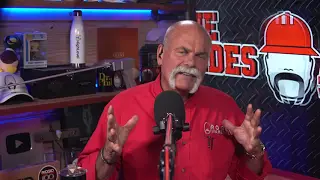Think your DIY van plumbing is top-notch? Let’s find out! Today, I’m rating a handful of real van life setups. You won’t believe what works and what could leave you in deep trouble. To keep it fun, I’m using a rating system of one to five mustaches.
I first got involved with van life when I saw a buddy, Neil from Urban Van Life, cut a hole in the side of his van. That video blew my mind, and I couldn’t look away. Then, I started seeing all the unique plumbing installations people were doing in their vans—some were impressive, and some…not so much.
Let’s jump in and see what’s happening.
Setup 1: A Minor Abby’s Luxury Sprinter Van
This setup features a complete plumbing system in a yellow 4×4 Sprinter van. The builder is using PEX tubing, a water heater, and a pump with an accumulator. The interior reveals a queen-sized bed (or twin), overhead storage, a kitchen sink, a walk-in shower, and a toilet.
- First Impressions
- PEX piping looks neat and organized.
- Red and blue lines indicate hot and cold supplies, making maintenance easier.
- The walk-in shower with a handheld sprayer and overhead rain shower head is a nice touch.
- Pros
- Efficiency: She has a pump and accumulator for consistent water pressure.
- Easy Use: Clearly labeled hot and cold lines.
- Cost-Effectiveness: PEX is generally affordable and reliable.
- Overall Look: Very professional, with a real bathroom feel inside the van.
- Rating
I give this system 4 out of 5 mustaches. It’s sharp, tight, and easy to use.
Setup 2: Nick and Drea’s Budget Ambulance Build
In an ambulance-turned-camper, they chose a completely manual system. There’s a simple foot pump for the kitchen sink and a 5-gallon fresh water tank. Their toilet is a self-contained holding tank that can be dumped at a standard dump station.
- First Impressions
- The water supply tank appears open at the top, raising concerns about pests or debris entering.
- Foot pump is ultra-basic—no electricity needed.
- Room temperature water can be quite cold in winter and hot in summer.
- Pros
- Efficiency: No complicated parts; less to break.
- Cost-Effectiveness: A 5-gallon jug and a foot pump keep costs down.
- Simple: Easy to maintain, just watch water levels and empty the toilet.
- Cons
- No Shower: Didn’t see a dedicated shower option.
- Open Tank Issue: Critters could sneak into the water supply.
- Rating
I give this system 3 out of 5 mustaches. It works but could be improved by sealing the tank and adding a shower.
Setup 3: Salty Van Ventures’ Underfloor Tanks
This Australian build uses large tanks mounted underneath the van to save space. They have a pump, a strainer, and a water heater inside. Their lines appear to be SharkBite PEX, which can be quick to install but requires careful assembly.
- First Impressions
- Underfloor mounting frees up interior room.
- A strainer keeps sediment out of the pump.
- 50 PSI operating pressure is reasonable for van life.
- Pros
- Efficiency: The system is pressurized with a dedicated pump switch.
- Easy Use: A standard 12v switch controls the pump on/off.
- Saves Space: Big interior area thanks to tanks outside.
- Potential Concern
- SharkBite in Hidden Areas: If not assembled correctly, leaks could be harder to spot.
- Rating
I give this 4 out of 5 mustaches. Great design, but I’d prefer crimp or clamp PEX over SharkBite for reliability.
Setup 4: Our Throbbing Life DIY
They have a freshwater tank, a pump, an accumulator, and a water heater. The notable choice is using flexible braided nylon hoses. There’s a pressure relief valve on the heater, but it looks like there’s no dedicated shutoff valve before the heater.
- First Impressions
- Braided hoses for potable water are not my favorite; PEX or another rigid option might be more secure.
- A filter strainer on the drain line is creative, preventing backflow or bugs entering from outside.
- Pros
- Cost-Effective: Basic hoses can be cheaper.
- Easy to Build: Quick connections, minimal specialized tools.
- Cons
- Longevity: Braided hoses can degrade under pressure and movement.
- No Dedicated Shutoff: Could be an issue for heater maintenance.
- Rating
I give this 2 out of 5 mustaches. It’s functional, but there’s room for major improvements in safety and durability.
Setup 5: Final DIY Van Build with Remote Ball Valve
This build uses a freshwater tank, a pump, accumulator, water heater, and a remote ball valve to drain the gray tank underneath. The shower has a self-cleaning door and the sink faucet can rotate or extend as a sprayer.
- First Impressions
- Filtration system for drinking water is a bonus.
- Remote ball valve to drain while driving is a cool feature.
- Did not see a detailed look at the piping, but presumably PEX or similar.
- Pros
- Efficiency: Pressurized system, easy draining on the go.
- Look: Shower with a fancy door, nice sink setup.
- User-Friendly: Electronics for draining, plus a water-level check.
- Rating
I give this 4 out of 5 mustaches. It looks modern, well-integrated, and quite convenient.
Conclusion
Plumbing in a van is never simple. You have to combine space-saving creativity with reliable fittings and proper design for potable water. Whether using hand pumps, foot pumps, or full-blown pressurized hot showers, the key is to ensure your pipes won’t leak, your water stays clean, and you can easily drain or fill your system.
If you’re jumping into van life plumbing, think carefully about your fittings, venting, and water heater options. And remember, always double-check for leaks and pests. If you enjoyed this overview, you’ll definitely like my next piece on DIY plumbing setups for tiny homes.




